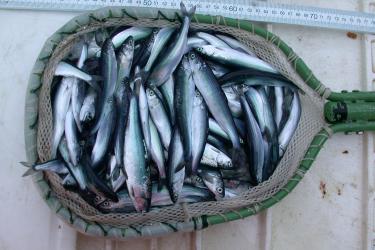Salmon play an essential role in Alaska ecosystems. They support commercial and recreational fisheries and are integral to the culture and food security of many Indigenous communities in Alaska. In response to historic declines of salmon runs on the Yukon and Kuskokwim rivers, Congress passed the Alaska Salmon Research Task Force Act and President Biden signed it into law in December 2022.
The Act requires the Secretary of Commerce, in consultation with the Governor of Alaska, to convene an Alaska Salmon Research Task Force. The Taske Force will identify data gaps and produce a coordinated science plan 1 year after coming into force.
The Task Force is charged with:
- Reviewing and reporting on research about the Pacific salmon in Alaska
- Identifying applied research needed to better understand salmon migration and declining salmon returns in some regions of Alaska
- Setting up a Yukon and Kuskokwim River work group
- Supporting sustainable management of salmon
“The work of the Alaska Salmon Research Task is critically important,” said Robert Foy, director, Alaska Fisheries Science Center, NOAA Fisheries. “We are grateful to the individuals who have agreed to serve as task force members and share their knowledge and expertise to develop a roadmap of where to go next with research to best understand and respond to the unprecedented changes in Alaska salmon runs.”
Task Force Membership
Per the Act, federal appointments include a representative from NOAA, the North Pacific Fishery Management Council, and the United States section of the Pacific Salmon Commission.
The legislation requires that the task force consist of between 13-19 members with representation (not less than two and not more than five) from each of the following sectors:
- Subsistence community
- Fishing industry and supporting supply chain businesses
- Academic community
At least two representatives must be Alaska Natives who possess personal knowledge of, and direct experience with, subsistence uses in rural Alaska.
Task Force Appointees
The 19 Task Force members represent a diversity of backgrounds and expertise.
Federal
- Andrew Munro (North Pacific Fishery Management Council)
- Ed Farley (NOAA Fisheries)
- Bill Templin (State of Alaska)
- Andy Piston (Pacific States Salmon Commission)
Subsistence Community
- Oscar Evon (Native Village of Kwigillingok)
- Jacob Ivanoff (Native Village of Unalakleet)
- Karla Jensen (Native Village of Pedro Bay)
- Caroline Brown (Alaska Department of Fish and Game Subsistence Director)
- Justin Leon (Kuskokwim River Inter-Tribal Fish Commission)
Fishing Industry
- Michelle Stratton (Alaska Marine Conservation Council/Commercial Salmon Fisherman)
- Mike Flores (Charter Boat Fisherman)
- Austin Estabrooks (At-Sea Processors Association)
- Tom Carpenter (Commercial Fisherman)
- Steve Reifenstuhl (Aquaculture Industry)
Academic Community
- Megan McPhee (University of Fairbanks)
- Megan Williams (Ocean Conservancy/University of Fairbanks)
- Tommy Sheridan (University of Fairbanks)
- Noelle Yochum (Alaska Pacific University/Trident Seafoods)
- Katie Howard (Alaska Pacific University/Alaska Department of Fish and Game)



